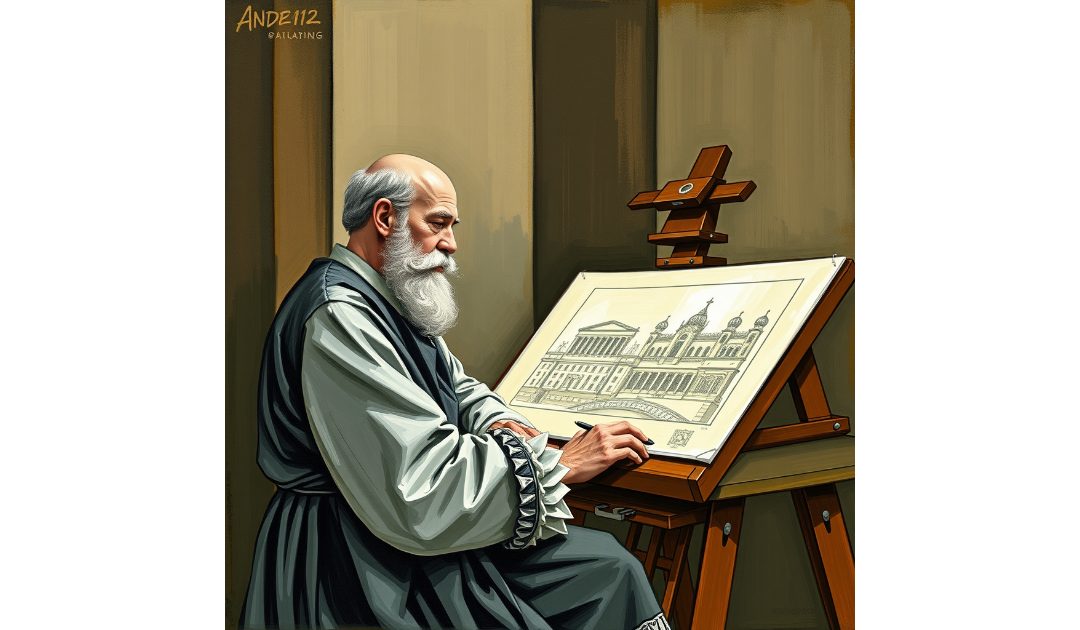On the 3rd of March, 1585, the Olympic Theatre in Vicenza was inaugurated. It was the final design of Andrea Palladio. Before I began creative writing I was a civil engineer, and worked with many great architects. Like great writing, great architecture lifts the soul. But, back to Palladio
Andrea Palladio (1508-1580) was an Italian architect whose work has had a profound and lasting impact on architecture, particularly in the Western tradition. Born in Padua, Palladio trained as a stonemason before becoming an architect, and he is best known for his innovative designs that combined classical Roman principles with Renaissance ideals. His architectural philosophy emphasised harmony, proportion, and the integration of buildings with their surroundings, which has influenced countless architects and movements throughout history.
Palladio’s early career was shaped by his exposure to the classical ruins of Rome, which he visited in the 1540s. This experience deeply influenced his understanding of architecture and design. He sought to revive the principles of ancient Roman architecture, believing that the beauty of a building lay in its proportions and symmetry. Palladio’s work is characterised by the use of columns, porticos, and pediments, elements drawn from classical architecture that he adapted to suit contemporary needs.
One of Palladio’s most significant contributions to architecture is his treatise, “I Quattro Libri dell’Architettura” (The Four Books of Architecture), published in 1570. This influential work outlined his architectural theories and showcased his designs, serving as a guide for architects and builders. The treatise emphasised the importance of proportion and symmetry, and it included detailed illustrations of his buildings, as well as examples from classical architecture. “The Four Books” became a foundational text for architects in the Renaissance and beyond, spreading Palladio’s ideas throughout Europe and influencing the development of neoclassical architecture.
Palladio’s most famous buildings include the Villa Capra, also known as La Rotonda, and the Basilica Palladiana in Vicenza. La Rotonda, completed in the 1560s, is renowned for its harmonious proportions and circular plan, featuring a central dome surrounded by four identical porticos. The villa exemplifies Palladio’s ability to blend architecture with the surrounding landscape, creating a sense of unity between the built environment and nature. Its design has inspired numerous country houses and villas across Europe and the Americas.
The Basilica Palladiana, another of Palladio’s masterpieces, showcases his innovative use of the classical orders. The building features a distinct loggia on the ground floor, supported by columns, and a series of arches that create a sense of rhythm and elegance. Palladio’s design transformed the existing structure into a grand civic space, reflecting the importance of public architecture in Renaissance society.
Palladio’s influence extended beyond Italy, particularly in England and America, where his principles were embraced by architects seeking to create buildings that embodied classical ideals. In England, Palladianism became a popular architectural style in the 17th and 18th centuries, with architects like Inigo Jones and Robert Adam drawing inspiration from Palladio’s work. In America, Palladian principles were applied to the design of public buildings and private homes, as seen in Thomas Jefferson’s Monticello and the Virginia State Capitol.
Despite his success, Palladio faced criticism during his lifetime, particularly from those who favored more ornate styles of architecture. However, his emphasis on simplicity, proportion, and the integration of buildings with their surroundings resonated with many, leading to his eventual recognition as one of the great masters of architecture.
Today, Andrea Palladio is celebrated as a pivotal figure in the history of architecture. His ideas continue to influence contemporary architects, and his buildings remain admired for their beauty and elegance. Palladio’s legacy is a testament to the enduring power of classical principles in shaping the built environment, and his work serves as a reminder of the importance of harmony and proportion in architecture. Through his innovative designs and influential writings, Palladio has left an indelible mark on the world of architecture, making him a key figure in the Renaissance and beyond.

